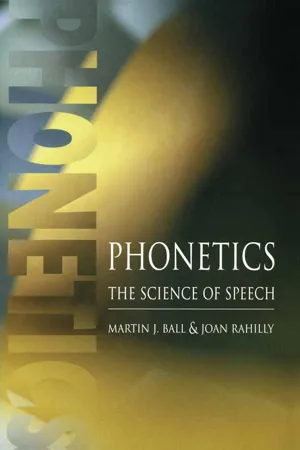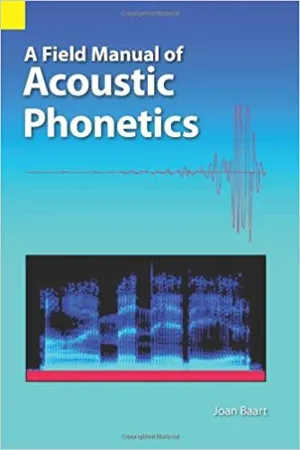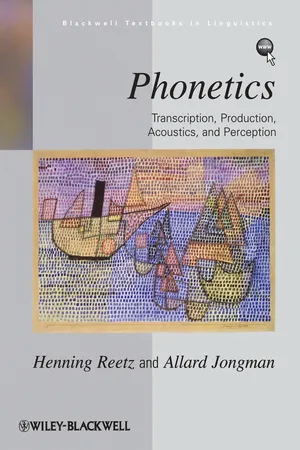Languages & Linguistics
Sound Spectrum
The sound spectrum refers to the range of frequencies that can be produced and perceived by the human ear. In linguistics, the sound spectrum is important for understanding the different sounds used in speech and how they are produced. It helps linguists analyze and categorize the various sounds found in different languages.
Written by Perlego with AI-assistance
Related key terms
Related key terms
1 of 4
Related key terms
1 of 3
4 Key excerpts on "Sound Spectrum"
- eBook - ePub
Phonetics
The Science of Speech
- Martin J Ball, Joan Rahilly(Authors)
- 2014(Publication Date)
- Routledge(Publisher)
In phonetics research, the notion of resonance allows us to classify speech sounds using spectra. Spectra are defined by Fry (1979, p. 58) as ‘statement[s] of what frequencies are to be found in the mixture and what their relative amplitudes are’. Later, we will examine the components of spectra in detail but, for the moment, it will suffice to state that spectral measurement allows us to measure the fundamental frequency, along with the harmonics that are present in speech.Basic methods in acoustic analysis—————As we stated at the beginning of this chapter, acoustic phonetics aims to provide a quantifiable record of speech events using instrumental techniques. These techniques are usually based around computer software packages, often interfaced with hardware which produce visual representations of and statistical measurements of speech. Although this explanation seems to represent acoustic phonetics as an exact science, we must point out that this is not the case. For instance, if we were using tape-recorded material as input, it may be the case that the quality of the recording is less than ideal (because of extraneous background noise, or inappropriate recording levels, for instance). It may also be that the chosen acoustic program fails to analyse the data in the best way, either because of its own design faults, or because we ourselves have failed to specify the correct settings for data sampling.Because of the potential difficulties outlined above, it is important to familiarize ourselves with good practice in recording techniques, and we should also equip ourselves with a solid understanding of the characteristics and methods of whatever acoustic analysis program we happen to be using. In addition to these prerequisites to acoustic analysis, we must also acquire a firm grasp of basic procedures in acoustics, and of how acoustic representations relate to articulatory characteristics of speech. The rest of this chapter concentrates on these aspects. - eBook - ePub
Handbook of Learning and Cognitive Processes (Volume 6)
Linguistic Functions in Cognitive Theory
- William Estes(Author)
- 2014(Publication Date)
- Psychology Press(Publisher)
3 The whole vowel space for a particular language seems to be organized in terms of sound contrasts that are highly discriminable. This is true of languages having as few as 3 to as many as 12 vowels. These two sets of findings are important because they indicate that the sound systems of natural languages are matched in some sense to attributes of both perception and production.It should be noted here that not all of the potential distinctive features at the phonetic level are used distinctively at a phonological level in any particular language. Similarly, no natural language has as many phonemes in its phonological system as there are logically possible combinations of utilized distinctive features. The sound systems of language appear to have evolved the way they are for several reasons. First, the distinctions are easily pronounceable for talkers. Second, these articulatory distinctions generate acoustic attributes that are highly distinctive, resulting in sounds that can be identified and discriminated under very poor listening conditions. In the next section, the results of experiments dealing with the perception of speech sounds are considered.IV. PERCEPTION OF SPEECH SOUNDS
The process of speech production imposes certain well-defined constraints on the resulting acoustic waveform. As noted, these constraints are derived from the anatomy and physiology of the vocal mechanism and the associated resonant properties. Although a good deal of work remains to be done in understanding and modeling the speech-perception process, there are a number of well-established empirical findings that define the problems in the field of speech perception and set it apart from other related areas such as auditory psychophysics and general auditory perception. It is possible to describe the research in speech perception in terms of two general lines of investigation: (a ) studies aimed at establishing the acoustic cues to the perception of speech-sound segments and (b ) studies aimed primarily at demonstrating the effects of manipulating syntactic and semantic variables on speech perception. The remainder of this chapter will be concerned primarily with experiments that fall into the first class of studies. Four major areas of research dealing with the perception of phonetic segments will be discussed: (a ) early research on the acoustic cues for stop consonants, (b ) experiments on the identification and discrimination of speech sounds, (c ) research on developmental aspects of speech perception in young infants, and, finally, (d - eBook - ePub
- Joan L. G. Baart(Author)
- 2018(Publication Date)
- SIL International(Publisher)
section 3.2.5 ). On the other hand, we can take a good look at the timing of events. The boundaries between the two vowels and the consonant can be seen (the formants belong to the vowels; the middle section without formants belongs to the plosive). Furthermore, we are able to discern the individual voicing pulses; they are seen as vertical dark lines that occur one after another during the vowels. No pulses are seen during the [p], which is voiceless.For most practical purposes, a speech researcher will inspect broad-band rather than narrow-band spectrograms. One reason is that the interest of the researcher is often in the formants, rather than in the separate harmonics. The detection of formants is actually facilitated by the blurring of information in the dimension of frequency. Another reason is that one often wants to see with some accuracy how acoustic parameters change over time, and for this purpose a good resolution in the time domain is required.3.1.4 SpectraA spectrum is a two-dimensional representation, with frequency displayed along the horizontal axis, and intensity along the vertical axis. A spectrum shows for a section of a sound wave what frequency components are present and what the relative intensities (strengths) of these components are. While a spectrogram gives a dynamic picture of a stretch of sound (it shows how acoustic parameters change over time), a spectrum gives a static picture: it has no time dimension.As with spectrograms, the appearance of a spectrum depends to an important extent on the size of the time window that is chosen for analysis. If a wave is periodic and the analysis window is smaller than the size of one cycle of the wave, then the analysis will be based on incomplete information. For the sake of precision, one would like to calculate a spectrum over as large a stretch of sound as possible. However, if one is interested in the spectral properties of only one vowel or consonant, one is constrained by the duration of that vowel or consonant. In fact, one will often be confined to a section in the middle of a segment, where the sound is maximally stationary, as the peripheral regions of speech sounds are often heavily influenced by neighboring sounds. - eBook - ePub
Phonetics
Transcription, Production, Acoustics, and Perception
- Henning Reetz, Allard Jongman(Authors)
- 2011(Publication Date)
- Wiley-Blackwell(Publisher)
10
Acoustic Characteristics of Speech Sounds
This chapter discusses the primary acoustic characteristics of a variety of speech sounds and illustrates them by means of spectrograms and spectra. We start with vowels and subsequently discuss consonants.10.1 Vowels
Vowels are produced with a relatively open vocal tract and the airstream is not severely impeded. The resulting acoustic signal is therefore relatively loud. In addition, vowels are usually produced with vocal fold vibration. The primary acoustic characteristic of vowels is the location of the formant frequencies, specifically, the first three formants (F1–F3). As discussed in Section 9.5.1, the shape of the vocal tract determines the location of the formant frequencies. Changes in the position of the articulators will modify the shape of the vocal tract and, as a result, the location of the formant frequencies. Since the same formant frequencies can be generated with a variety of articulatory positions, formant frequency location is a critical determinant of vowel quality rather than the positions of the articulators. For a given speaker or for a group of speakers with the same vocal tract length, each vowel is associated with a distinct acoustic formant frequency pattern. As an example, Figure 10.1 shows spectrograms and linear predictive coding (LPC) spectra of the vowels [i] and [ɑ] spoken by a male English speaker.Figure 10.1 (a, c) Spectrograms and (b, d) LPC spectra of the English vowels [i] and [ɑ] produced by a male speaker.As on any spectrogram, frequency is plotted along the vertical axis, and time along the horizontal axis. Intensity is represented by the darkness of the display. The darker a particular area, the greater its intensity. The spectrograms of the two vowels have several things in common. They are both characterized by the presence of a number of dark bands along the frequency scale. These dark bands correspond to the formant frequencies that reflect the resonances of the vocal tract and appear as “peaks” in the LPC spectrum.
Index pages curate the most relevant extracts from our library of academic textbooks. They’ve been created using an in-house natural language model (NLM), each adding context and meaning to key research topics.
Explore more topic indexes
Explore more topic indexes
1 of 6
Explore more topic indexes
1 of 4



